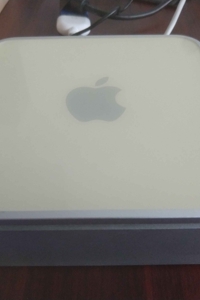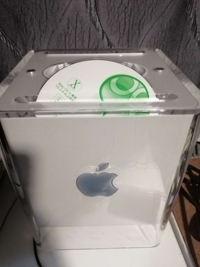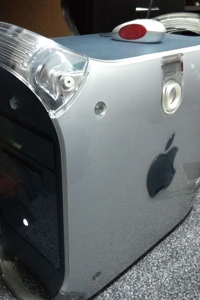My PowerMac Collection - And yes, I still intend to get more!
- Mac Mini G4
- Release date: 22nd January, 2005
- Obtained on: 27th August 2025
- CPU: PowerPC G4 1.25GHz
- Memory: 1GB SDRAM 333MHz
- GPU: ATI Radeon 9200 32MB VRAM
- Operating Systems: Mac OS 9.2.2, Mac OS X 10.4

A very small form factor PowerMac, with a size just a little bit smaller than the SEGA Dreamcast. Mac Minis are still made to this day, but only the first generation Mac Minis were PowerMacs with PowerPC processors, with future generations using Intel or Apple Silicon processors instead.
Owing to the Mac Mini debuting in 2005, three years after Mac OS 9 was discontinued, this computer doesn't officially support Mac OS 9 in spite of meeting the classic OS’s system requirements. Fortunately, unofficial fan-made installers that allow you to run OS 9.2.2 on a Mac Mini now exist, resulting in the computer becoming a favoured OS 9 machine in the retro Mac community. In spite of the extra hoop you need to jump through to get it running OS 9, it's appreciated for its small size and its specs being powerful enough to run even the most demanding Mac OS 9 games. There is a notable drawback however, which is that volume control for whatever reason is non-functional in Mac OS 9 when running on a Mac Mini, thus requiring external computer speakers with physical volume dials to manage sound.
The Mac Mini comes with a built-in CD/DVD drive, two USB slots, a single firewire slot, a headphone jack, ethernet port and DVI video output. The computer itself also has a (low quality) built-in speaker. Unlike my other PowerMacs, the Mac Mini is very tightly sealed and difficult to open up and replace parts in. I’d love to replace the hard drive with a larger SSD at some point when I’m feeling more daring.
- PowerMac G4 Cube
- Release date: 19th July, 2000
- Obtained on: 21st June 2020
- CPU: PowerPC G4 450MHz
- Memory: 1GB SDRAM PC133-333
- GPU: ATI Radeon 7000 32MB VRAM
- Operating Systems: Mac OS 9.0.4, Mac OS 9.2.2, Mac OS X 10.4

This is more or less the predecessor to the Mac Mini. It’s also on the small side as far as desktop computers go, but it’s much taller than the Mac Mini, even if the diameter is similar. Size-wise it’s comparable to uhhh… let’s go with three Dreamcasts stacked on top of each other.
The Cube has its fair share of design issues, such as how prone it is to overheating due to the lack of any internal fans. It had a fairly limited run and was considered a failure with only 150,000 units sold before being discontinued, but it has since become more appreciated by retro computer enthusiasts due to its uniqueness. I’ve written a more extensive blog post about the Cube and its unusual design here.
- PowerMac G4 Gigabit
- Release date: 19th July, 2000
- Obtained on: 26th August 2024
- CPU: PowerPC G4 400MHz
- Memory: 512MB SDRAM PC133-333
- GPU: ATI Rage 128 Pro
- Operating Systems: Mac OS 8.6, Mac OS 9.0.4, Mac OS 9.2.2

The only full tower computer in my PowerMac collection. It’s big, bulky, noisy, and in spite of all of that, far less powerful than my other two much smaller PowerMacs. I bought this model mistakenly thinking that it was capable of running Mac OS 8.6, only to find out that it has the exact same OS compatibility as the G4 Cube. Oops. After some searching around forums however, I discovered that much like the Mac Mini with Mac OS 9.2.2, although the Gigabit doesn’t officially support Mac OS 8.6, that hasn’t stopped fans from finding out ways to unofficially install 8.6.
Honestly, given that this model came out the exact same day as the G4 Cube, I’m slightly baffled by the fact that in spite of that it’s actually weaker than its smaller cousin, but then again it was $200 cheaper than the Cube on release. It also mostly has the same ports as the Cube, so you’re still stuck with just two USB ports in spite of the size of the computer. At least you have a built-in speaker and a headphone jack this time however, in addition to a Zip drive included alongside the CD/DVD drive.
Current wishlist
No, this is still not enough! Namely, all of my current PowerMacs are desktop computers, and they also are all from the year 2000 onwards. In the future I would like to track down...
- Any computer capable of running Mac OS System 7
- An all-in-one iMac desktop capable of running Mac OS 8 (like the iMac my family used to own which I used as a kid)
- A G3 Clamshell PowerBook
- An even older PowerBook model, one of those chunky dark grey coloured ones that runs System 7
- Not PowerMacs, but I'm also keen to get an older Motorola 68000 Macintosh, as well as an Apple IIGS
